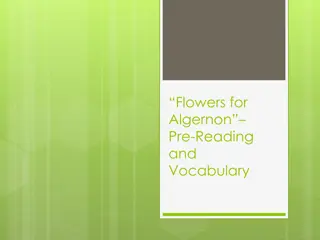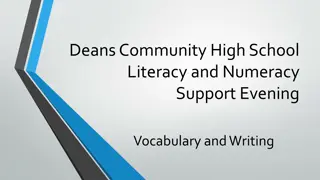Effective Pre-Teaching Vocabulary Strategies for ELs
ELs benefit from specific pre-teaching vocabulary strategies such as selecting important words, providing contextual understanding, offering student-friendly definitions, and engaging in oral interactions. Massachusetts Department of Elementary and Secondary Education emphasizes the importance of choosing relevant vocabulary and utilizing various strategies to enhance conceptual understanding. The 7-step approach includes teacher-led word repetition, contextual usage, dictionary definitions, student-friendly explanations, word features highlighting, oral interaction for knowledge development, and clarification on new word usage without student writing.
Download Presentation

Please find below an Image/Link to download the presentation.
The content on the website is provided AS IS for your information and personal use only. It may not be sold, licensed, or shared on other websites without obtaining consent from the author.If you encounter any issues during the download, it is possible that the publisher has removed the file from their server.
You are allowed to download the files provided on this website for personal or commercial use, subject to the condition that they are used lawfully. All files are the property of their respective owners.
The content on the website is provided AS IS for your information and personal use only. It may not be sold, licensed, or shared on other websites without obtaining consent from the author.
E N D
Presentation Transcript
Vocabulary Strategy 7 Steps for Pre-Teaching Vocabulary
Vocabulary Instruction ELs should be given ample opportunities and encouraged to communicate with English- proficient speakers, for it is in this way the second languages are predominantly acquired. (Ellis, 2005) Several strategies are especially valuable for ELs, including taking advantage of students first language if the language shares cognates with English, ensuring that ELs know the meanings of basic words, and providing sufficient review and reinforcement. (August, Carlo, Dressler, Snow, 2005) 2 Massachusetts Department of Elementary and Secondary Education
Choosing Vocabulary to Teach Consider Importance and utility Instructional potential Conceptual understanding 3 Massachusetts Department of Elementary and Secondary Education Source: Beck et. al. 2002, Bringing Words to Life
7 Steps for Pre-Teaching Vocabulary 1. Teacher says the word. Students repeat 3 times. 2. Teacher states the word in context from the text. 3. Teacher provides the dictionary definition(s). 4. Teacher explains the meaning using student- friendly definitions. 5. Teacher highlights features of the word: polysemous, cognate, tense, prefixes, etc. 6. Teacher engages students in oral interaction to develop word/concept knowledge. Students paired for maximum participation. (Timed 1 min student interaction.) 7. Teacher reminds and explains to students of how new words will be used. There is NO writing by students at this time. Margarita Calder n & Associates, Inc. 4 Massachusetts Department of Elementary and Secondary Education
7 Steps 2 or 3 minutes per word maximum! 1. Teacher says the word. Student repeats 3 times. 1.Teacher: alarming Students: alarming (repeat 3 times) 2. Now, a group of scientists and beekeepers has teamed up to try to figure out what s causing the alarming collapse of so many colonies 3. (Adjective)causing people to feel danger; to be worried or frightened 2. Teacher states the word in context from the mentor text. 3. Teacher provides the dictionary definition(s). 4. Teacher explains the meaning using student- friendly definitions. 5 4. When something is frightening or distressing, we say it is alarming Margarita Calder n & Associates, Inc.
7 Steps 2 or 3 minutes per word maximum! 5. Teacher highlights features of the word: polysemous, cognate, tense, prefixes, etc. 6. Teacher engages students in oral activities (in pairs to have 50% of students at any one time using the word aloud in a meaningful context) to develop word/concept knowledge. 5. alarming is a cognate in many other languages. It has an ing but is used as an adjective in this text alarming collapse 6. With a partner, use the expression: An example of something alarming is . (1 min) or It can be alarming when 7. You will see this word when we read and you should use it during partner reading summaries, homework, or when we work in class. 7. Teacher reminds and explains to students how new words will be used. There is NO writing by students at this time. 6 Margarita Calder n & Associates, Inc.
7 Steps 2 or 3 minutes per word maximum! 1. Teacher says the word. Students repeat 3 times. 2. Teacher states the word in context from the text. 3. Teacher provides the dictionary definition(s). 4. Teacher explains the meaning using student-friendly definitions. 5. Teacher highlights features of the word: polysemous, cognate, tense, prefixes, etc. 6. Teacher engages students in oral interaction to develop word/concept knowledge. Paired activity for maximum interaction. (Timed 1 min student interaction.) 7. Teacher reminds and explains to students of how new words will be used. There is NO writing by students at this time. 7 Massachusetts Department of Elementary and Secondary Education Margarita Calder n & Associates, Inc.























